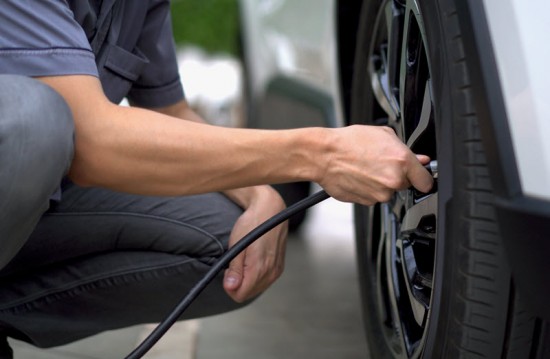|
On your car, there are only four parts that connect it with the road below–the tires. It is important to treat your tires with the utmost respect, so they will take care of you.
Like any other car part, tires need proper care and maintenance to ensure that they are performing to the best of their ability. While it would be great to put tires on and not worry about them for 20,000 or 30,000 kilometres, they do require regular maintenance to keep them in top condition. However, proper tire maintenance can be quite simple by being attentive to these few things.

Tire Rotation and Balancing
Rotating your tires is a regular part of tire maintenance as well as one of the most important parts. Your vehicle’s owner’s manual will outline a tire rotation schedule, usually every 5,000-7,000 kilometres. During a rotation, service technicians will remove each wheel from your vehicle and place it in a different location to ensure that your tire treads wear evenly. So, the front driver’s tire would be moved to the back passenger side, etc.
It is important to have your tires rotated on schedule and have them balanced as necessary. If you notice any vibration while driving, it could be due to improperly balanced tires. When you get your tires balanced, technicians attach small weights to the wheels to limit vibration of the tires as they turn. This helps to minimize uneven wear and extend tire life.
Air Pressure
Air pressure is an essential part of tire maintenance. Fortunately, some vehicle models include Tire Pressure Monitoring Systems (TPMS) built in, allowing you to check air pressure without even having to leave your vehicle. However, it is still important to use a tire pressure gauge to check your tires’ air pressures once a month and ensure that the tires are at or near your vehicle’s recommended tire pressure, as listed in the owner’s manual.
Low air pressure not only decreases the fuel efficiency of your vehicle, but it also reduces the life of your tires and increases the risk of a blowout. Many accidents are caused by underinflated tires, and you can ensure proper tire pressure by taking five minutes every month to check it.
Tread Depth
It is important to keep an eye on your tires’ tread depth because tread is what maintains traction and sheds water on wet roads. Worn-down tires are at a higher risk of hydroplaning and have an increased stopping distance, sometimes up to 25% longer.
If your tires have more than 4/32″ of tread, they are fine for continued use. If it is below that, it is time to start shopping for new tires. If your tires have less than 2/32″ of tread, they will need to be replaced immediately as they are unsafe for travel and will increase the likelihood of an accident, especially in wet conditions.
.jpg)
Proper tire care stabilizes the tire structure and can extend the life of a tire by almost 7,500 km. Caring for your tires is like caring for any other part of your car. It is important to follow the recommended maintenance schedule, and it is easy to inspect and check them in just a few minutes each month. If you ever have questions about tires, or the proper care for your particular tires, our Parts department is here to help!
|